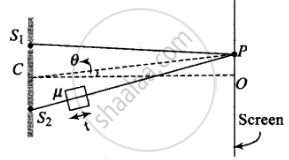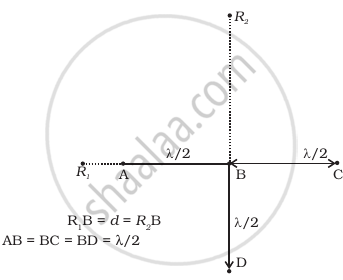Advertisements
Advertisements
Question

AC = CO = D, S1C = S2C = d << D
A small transparent slab containing material of µ = 1.5 is placed along AS2 (Figure). What will be the distance from O of the principal maxima and of the first minima on either side of the principal maxima obtained in the absence of the glass slab?
Solution
When we introduce a thin transparent plate in front of one of the slits in YDSE, the fridge pattern shifts toward the side where the plate is present.

`(S_2O^')_("new") = (S_2O^' - t)_("air") + t_("plate") = (S_2O^' - t)_("air") + mut_("air")`
`(S_2O^')_("new") = S_2O^' + [mu(t - 1)]`
Path difference, `Δx = (S_2O^')_("new") - S_1O^' = (S_2O^' - S_1O^') + [mu(t - 1)]`
⇒ `Δx = d sin theta + [mu(t - 1)]` ......(i)
⇒ Additional path difference = `(mu - 1)t`
Here the separation between the slits = S1S2 = 2d. Hence for calculating path difference, equation (i) becomes `Δx = 2d sin theta + [mu(t - 1)]`
For the principal maxima, (path difference is zero)
`Δx = 2d sin theta_0 + [mu(t - 1)]` = 0
`sin theta_0 = - (L(mu - 1))/(2d) = (-L(0.5))/(2d)` .....[∵ L = d/4]
or ⇒ `sin theta_0 = (-1)/16`
θ0 is the angular position corresponding to the principal maxima
⇒ `OP = D tan theta_0 ≈ D sin theta_0 = (_D)/16`
For the first minima, the path difference is `+- λ/2`
`Δx = 2d sin theta_1 + 0.5 L = +- λ/2`
`sin theta_1 = (+- λ/2 - 0.5 L)/(2d) = (+- λ/2 - d/8)/(2d)`
⇒ `sin theta_1 = (+- λ/2 - λ/8)/(2λ) = +- 1/4 - 1/16` ......[∵ The diffraction occurs if the wavelength of waves is nearly equal to the side width (d)]
On the positive side `sin theta_1^+ = + 1/4 - 1/16 = 3/16`
On the negative side `sin theta_1^- = 1/4 - 1/16 = - 5/16`
The first principal maxima on the positive side is at distance
`D tan theta"'"_1^+ = D (sin theta"'"_1^+)/sqrt(1 - sin^2 theta_1^') = D 3/sqrt(16^2 - 3^2) = (3D)/sqrt(247)` above point O
The first principal minima on the negative side is at distance
`D tan theta_1^+ = (5D)/sqrt(16^2 - 5^2) = (5D)/sqrt(231)` below point O.
APPEARS IN
RELATED QUESTIONS
What is 'diffraction of light'
In the diffraction pattern due to a single slit of width 'd' with incident light of wavelength 'λ', at an angle of diffraction θ. the condition for first minimum is ....
(a)`lambda sin theta =d`
(b) `d costheta =lambda`
(c)`d sintheta=lambda`
(d) `lambda cos theta=d`
Describe briefly how a diffraction pattern is obtained on a screen due to a single narrow slit illuminated by a monochromatic source of light. Hence obtain the conditions for the angular width of secondary maxima and secondary minima.
What should be the order of obstacle or aperture for diffraction of light?
Wavelength of light of frequency 100 Hz is
Diffraction effects are easy to notice in the case of sound waves than in case of light waves because
Which of the following device is used to study the spectra of light?
Four identical monochromatic sources A, B, C, D as shown in the (Figure) produce waves of the same wavelength λ and are coherent. Two receiver R1 and R2 are at great but equal distances from B.
- Which of the two receivers picks up the larger signal?
- Which of the two receivers picks up the larger signal when B is turned off?
- Which of the two receivers picks up the larger signal when D is turned off?
- Which of the two receivers can distinguish which of the sources B or D has been turned off?

In a diffraction pattern due to a single slit, how will the angular width of the central maximum change, if orange light is used in place of green light?
Justify your answer.
In a diffraction pattern due to a single slit, how will the angular width of the central maximum change, if the screen is moved closer to the slit?
Justify your answer.
